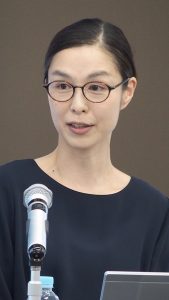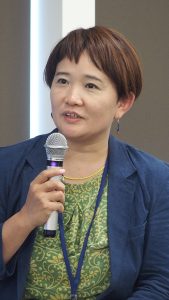International Symposium “The Philosopher and the Princess: Freedom, Love, and Democracy in Cold War Japan”
On the 19th of May 2019, the Institute for Gender Studies (IGS) hosted the international symposium, ‘The Philosopher and the Princess: Freedom, Love, and Democracy in Cold War Japan’, which was coordinated by Jan Bardsley (Specially Appointed Professor, IGS/ Professor, The University of North Carolina at Chapel Hill). Professor Bardsley and Julia C. Bullock (Associate Professor, Emory University) made keynote speeches. Aya Kitamura (Lecturer, Tsuda University) and Gaye Rowley (Professor, Waseda University) were invited as discussants, and Fumie Ohashi (Associate Professor, IGS) served as the moderator.
The post-war democracy and economic development in Japan begot new insights among young women in Japan in the 1950s and 1960s. The French feminist philosopher Simone de Beauvoir and the Japanese Crown Princess Michiko became role models who introduced these women to new ways of living their lives. De Beauvoir, for example, encouraged women to obtain financial independence, and her romantic relationship with Jean-Paul Sartre represented a new form of love. Michiko Shoda, on the other hand, married the crown prince and became what others regarded as a perfect housewife. At first glance, these two women’s paths in life might seem very different, but they were both women who dreamt of freedom, opportunities for self-discovery and love. Bardsley’s presentation on Princess Michiko (‘Romance Revisited: The Royal Wedding of 1959 Viewed Sixty Years Later’) and Bullock’s presentation on de Beauvoir (‘Beauvoir in Japan: Japanese Women and The Second Sex’) shed light on the differences and similarities between these two formidable women in history.
In her presentation, Bardsley explained how Princess Michiko’s life empowered women to dream about becoming a princess. In Japan, a commoner marrying a crown prince for love was an improbable fairy tale prior to the Second World War. Their royal wedding in 1959 can be seen as a projection of youth and beauty (as presented by the princess) and the success of the post-war democratic reform. When she became a mother, the progressive princess did not follow the royal family tradition; instead, she willingly took responsibility for childcare and housework. This iconic ‘Princess Homemaker’ who supported her husband as a housewife, became a model for the post-war family in the 1960s. The media praised her image, and young women aspired to become a homemaker like the princess. She was perceived as a woman who realised her dreams of freedom, self-discovery and love.
However, some women did not approve of such a lifestyle. Bullock discussed the women who were against the idea of pursuing a ‘carrier’ of becoming a wife and mother. These women were attracted to their vision of freedom, which de Beauvoir presented in her book The Second Sex. This freedom was to be secured through financial independence and professional success. In the 1960s, Japanese society and politics moved towards a conservative viewpoint, and the post-war reforms in Japan were set aside. This development coincided with Princess Michiko’s appearance as the perfect homemaker. While the younger generation supported gender equality which the post-war reform envisioned, the princess revived an old fashioned idea of femininity (i.e. ’Good Wife, Wise Mother’). At the same time, Japanese women who read de Beauvoir’s first memoir published in 1961 discovered that she had managed to establish financial and intellectual independence. Japanese women admired her for her independence and her open relationship with Sartre.
Japanese feminists, however, criticised her discussions about the liberation of women, interpreting them as a denial of motherhood and femininity. De Beauvoir’s well-known statement in The Second Sex, ‘One is not born, but rather becomes, a woman’, presently describes the concept of gender. However, in 1953, some of her arguments were mistranslated and turned de Beauvoir’s criticism of gender into negative expressions about women’s bodies. Thanks to a series of movements in the following decades—which included a re-evaluation of de Beauvoir’s work after her death in 1986, the development of women’s and gender studies in Japan and the publication of a new, ‘decisive’ Japanese translation of the book—the misunderstanding was cleared, and Japanese feminists rediscovered de Beauvoir’s philosophy. Today, her writings are read as important literature in gender studies, and they inspire the women fighting against persistent traditional gender norms in contemporary society.
In response to the presentations by Bardsley and Bullock, Kitamura discussed the risk of generalisation of people by category. For example, she argues that people tend to talk about ‘Japanese women’ as a group of identical people without giving much consideration to the variation within the group. Among Japanese women, there were those who admired Princess Michiko and those who worshipped de Beauvoir. Although their lifestyles and attitudes seem different, they were all ‘Japanese women’. Moreover, Kitamura pointed out, there must have been other types of Japanese women who were excluded from these two urban, middle-class groups. For example, in the farming villages, some women were working like men while seeking ways to spend more time on homemaking and childcare. In other words, although these women had acquired independence and freedom, which de Beauvoir preached, they dreamt of becoming a housewife like Princess Michiko. Furthermore, aside from diversity, class structures and power relationships also exist among Japanese women. The second wave of feminism, which was inspired by de Beauvoir’s philosophy, is often criticised for overlooking the diversity among Japanese women. In recent years, however, a movement to establish inclusive societies for transgender people activated the debate on who and what a woman is. There are always questions about who should be included or excluded when a social category is presented. These matters of categorisation interest Kitamura, and she is researching how we cannot speak of ‘the Japanese Women’.
Rowley discussed the enduring value of de Beauvoir’s arguments by focusing on the speech she gave at the Tokyo Metropolitan Hibiya Public Hall in 1966, ‘Women and Creativity’. In the speech, de Beauvoir argued that women’s underachievement in various fields (such as politics, philosophy and the arts) was not because they were less capable than men. To support her argument, she referred to the Japanese historical figure Murasaki Shikibu, who was the author of The Tale of Genji. In her girlhood, Murasaki Shikibu read classical Chinese literature very well. When her father discovered this, he lamented over his misfortune. If only she were a boy, he said. The story suggests that boys are raised to be ambitious and girls are excluded from that kind of expectation. De Beauvoir argued that such exclusion prevented women from being successful in their professional careers. She stressed that, in this way, women’s opportunities to express their creativity were limited, and they had to fight for a chance to prove themselves. These issues surrounding gender inequality, which de Beauvoir pointed out in the 1960s, still permeate society and are continuously challenged. Also, the women affected by gender inequality are now aware that they share these challenges with other minority groups and people who experience multiple or intersectional forms of discrimination. Half a century ago, de Beauvoir preached the importance of freedom and self-discovery, and that advocacy has the same significance in the 21st century. Rowley stressed that the teaching of de Beauvoir’s text in university classrooms is still meaningful and relevant.
The discussions presented in the keynote speeches and comments were deepened in the Q&A sessions. In these sessions, participants raised topics such as existentialism, sexuality and gender equality indexes. The discussions on translation—an essential part of all the speakers’ works—were lively. The discussions emphasised that translation is a complicated process that involves reading between the lines and taking cultural background into account. Translation is not a simple and systematic process of replacing words; it is an act of transmitting information and meaning through a translator as the medium. Because translation inevitably involves the perspective of the translator, questions about neutrality are always raised. Researchers who take on global research projects and present the outcomes must keep such a cross-cultural aspect in mind. The presentations and discussions were thought-provoking.
【Event Information】 http://www2.igs.ocha.ac.jp/en/events/2019/04/0519/







